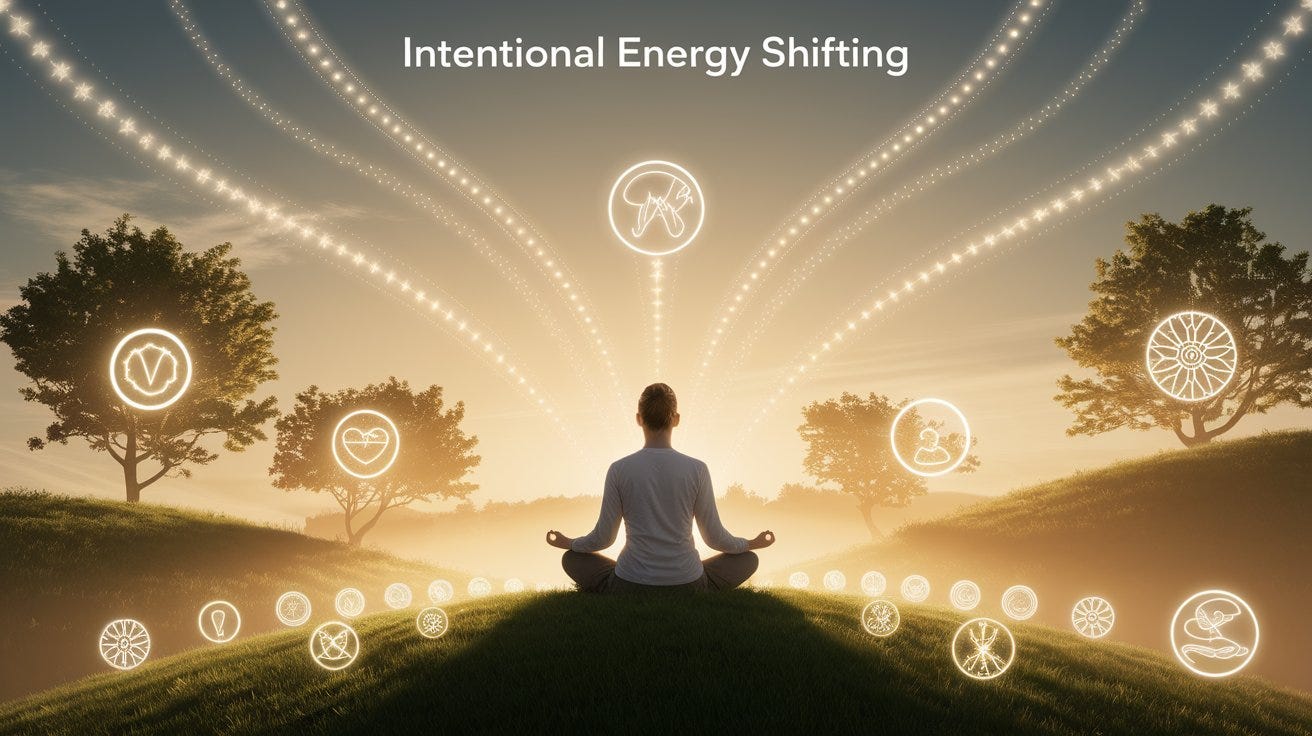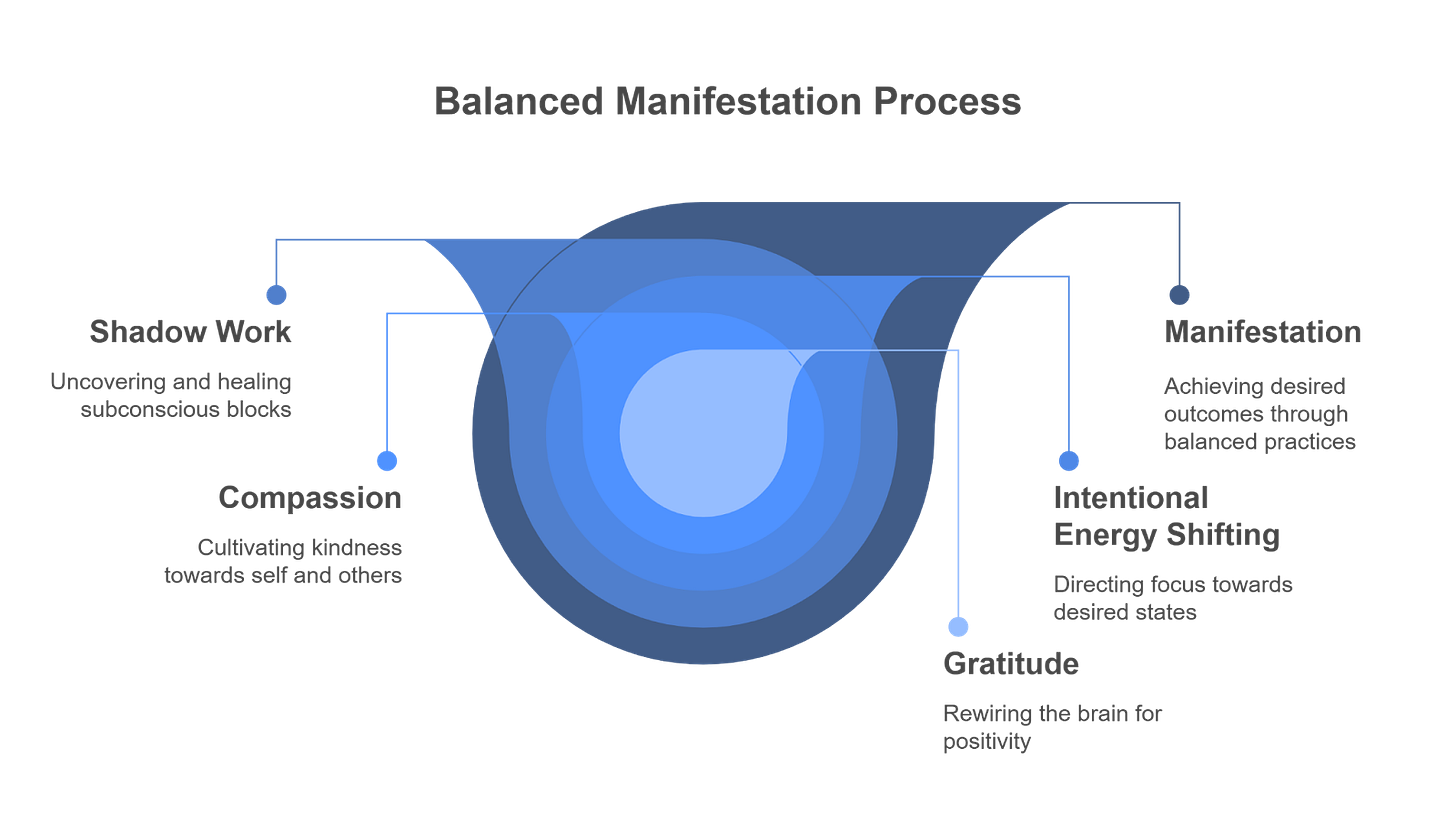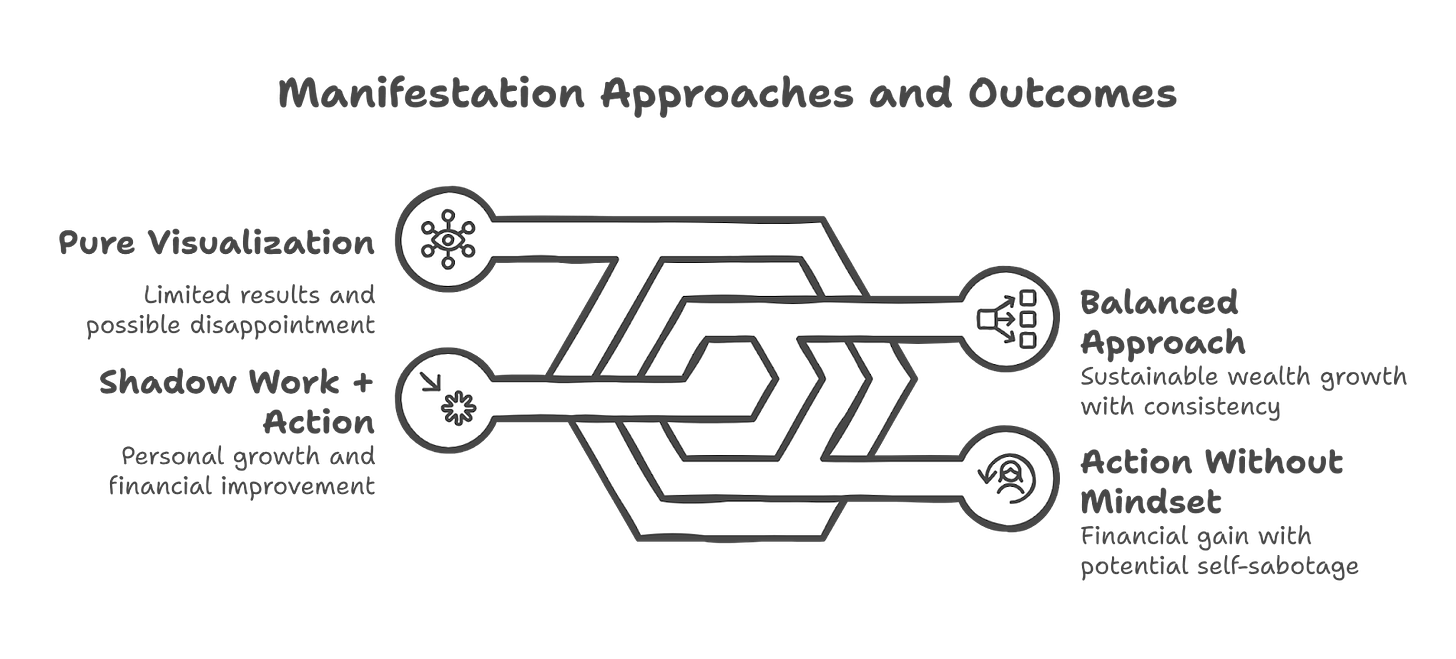Is Wealth Just a Thought Away? The Science Behind the Law of Attraction
Exploring the Science, Psychology, and Pitfalls Behind Manifesting Wealth
Have you ever wondered if your thoughts could literally create your financial reality? The "Law of Attraction" suggests that through positive thinking and visualization, you can manifest wealth and success into your life. But is there any scientific truth to this popular concept, or is it simply wishful thinking?
This post examines the evidence behind manifestation claims, explores both supporting research and skeptical perspectives, and offers practical approaches for those curious about applying these principles without abandoning critical thinking.
Understanding the Law of Attraction
The Law of Attraction is essentially a philosophy suggesting that positive or negative thoughts attract corresponding experiences into your life. It's the principle that "like attracts like" - what we put out into the universe, we receive back, because everything, even thoughts and feelings, supposedly carry a vibration.
Proponents of this concept believe that by maintaining positive thoughts and feelings about what you desire, you become a "vibrational match" for those things, allowing them to manifest in your reality. This applies to everything from relationships to career opportunities, and perhaps most popularly, to financial abundance.
Historical and Cultural Context
While the Law of Attraction gained mainstream attention with the 2006 release of The Secret, its roots trace back to earlier philosophical and spiritual traditions:
New Thought Movement: Emerging in the late 19th and early 20th centuries, this movement emphasized the power of the mind in shaping reality. Thinkers like Phineas Quimby, Mary Baker Eddy, and Emma Curtis Hopkins contributed to ideas about mental healing and positive thinking.
Influence of Eastern Philosophies: The New Thought Movement drew inspiration from Hindu philosophy, particularly the Upanishads, integrating concepts about consciousness and the nature of reality.
Quantum Physics Misinterpretations: Some proponents of the Law of Attraction attempt to link it to quantum physics, suggesting that thoughts can influence reality at a subatomic level. However, the scientific community largely disputes these connections, viewing them as misinterpretations or oversimplifications of complex scientific principles.
The Scientific Perspective
Let's address the elephant in the room: scientifically speaking, there's no concrete evidence that says the law of attraction actually exists as described by its proponents. The idea that thinking about wealth will somehow magnetically draw money toward you lacks empirical support. However, some scientific concepts do align with certain aspects of manifestation practices:
Positive vs. Negative Feedback Loops
Research indicates that positive feedback from supervisors can enhance intrinsic motivation and performance. A study published in Frontiers in Psychology found that supervisor positive feedback promotes intrinsic motivation, leading to extra-role performance among subordinates. This suggests that positive reinforcement can encourage individuals to exceed their standard job requirements.
Furthermore, Gallup data shows that 80% of employees who received meaningful feedback in the past week are fully engaged, highlighting the importance of timely and positive feedback in the workplace.
Neuroplasticity
Neuroplasticity refers to the brain's ability to reorganize itself by forming new neural connections throughout life. This adaptability means our thoughts and experiences can physically alter the brain's structure and function.
Positive affirmations leverage neuroplasticity by reinforcing beneficial neural pathways. According to Psychology Today, affirmations can help challenge and defeat self-sabotaging thoughts, effectively "reprogramming" our brains. Similarly, Old Dominion University notes that positive thinking can rewire your brain, changing the way you feel about things.
Functional MRI studies have shown that self-affirmation activates brain systems associated with self-related processing and reward, particularly in the ventromedial prefrontal cortex (VMPFC). This activation is linked to imagining positive future events and anticipating rewards.
Mirror Neurons
Mirror neurons are specialized brain cells that respond both when we perform an action and when we observe someone else performing the same action. This mirroring mechanism is thought to play a role in learning through imitation and understanding others' actions.
Studies suggest that visualizing an activity can activate similar neural pathways as actually performing the activity. For instance, imagining the performance of a skill can strengthen the same neural circuits involved in executing the skill, potentially enhancing performance.
Additionally, research indicates that mirror neurons impact our ability to grasp new skills, acquire knowledge, and form deep emotional connections, even helping us understand why people do what they do.
The Psychological Angle
While the metaphysical claims of the Law of Attraction lack scientific support, the psychological benefits of positive thinking and visualization are better established.
A 2005 review found that people with positive affect were more likely to enjoy increased levels of happiness and success. Similarly, a 2010 review discovered that visualizing your desires increased the likelihood of them becoming reality.
Visualization and Goal Achievement
Visualization works as a mental rehearsal that prepares your mind for success. When you vividly imagine achieving your financial goals, you:
Increase motivation toward goal-directed behaviors
Reduce anxiety about taking necessary steps
Program your reticular activating system (RAS) to notice opportunities you might otherwise miss
Build confidence in your ability to succeed
The Dark Side: When Manifestation Goes Wrong
Despite potential benefits, the Law of Attraction has some concerning downsides when practiced dogmatically.
Toxic Positivity and Emotional Repression
"There's a massive culture of toxic positivity that has arisen as a result of the law of attraction trend," says spiritual wellness coach Emma Halley. Some people have oversimplified the method of just forcing a positive mindset in all situations, which can lead to dangerous emotional repression.
This approach risks invalidating genuine emotional states and mental well-being. Negative feelings and low moods are valid experiences that need acknowledgment before healing can occur. Over time, pushing away emotions can contribute to serious mental health conditions.
The Blame Game
Another troubling aspect is how the Law of Attraction can be used to blame people for their misfortunes. If everything in your life is supposedly attracted by your thoughts, this implies that poverty, illness, or tragedy must be the fault of those experiencing them, a deeply problematic perspective that ignores systemic issues and random misfortune.
A Balanced Approach to Manifestation
For skeptical but curious professionals, manifestation doesn't have to mean blind faith in "wishful thinking." A more grounded approach incorporates proven psychological techniques such as setting clear intentions, visualizing outcomes, and practicing gratitude while steering clear of magical thinking and toxic positivity. It's about harnessing the benefits of a positive mindset without disconnecting from the full range of human emotion.
Honor Your Emotions First
One of the key principles of a healthy manifestation practice is emotional honesty. Instead of forcing yourself to maintain a constant state of positivity, it's essential to acknowledge and validate your authentic emotional experiences. Ignoring or suppressing difficult feelings in the name of "staying positive" can actually backfire, creating deeper psychological distress over time.
"When we deny or repress our true feelings, we can become stuck," explains psychotherapist Emmy Brunner. "It's vital for us to create worlds where we feel seen and heard. There's value in being able to connect with and process challenging emotions. It's not about aspiring to a life where we don't experience the shadows."
Allowing yourself to experience anger, sadness, fear, or doubt doesn't make you a failure at manifestation it makes you human. In fact, fully processing these emotions can lead to greater clarity, resilience, and inner alignment, ultimately making your goals feel more attainable and authentic. Growth often comes not from avoiding discomfort, but from working through it with awareness and self-compassion.
Instead of using positivity as a shield, this balanced approach invites you to use it as a tool—a conscious, flexible mindset that supports your journey without denying the complexity of your emotional life. By honoring the full spectrum of your feelings, you create a foundation that's not only emotionally sustainable but also genuinely empowering.
Practical Steps for Healthier Manifestation
Feel Your Feelings
Sitting with uncomfortable emotions rather than avoiding them can be powerful. From a manifestation perspective, this may release resistant energy that prevents desires from manifesting.
"Honor yourself by simply being somewhere quiet and allowing the emotion to bubble up within you," Halley advises. "Observe it with interest and ask yourself, 'Why do I feel like this?' When you shine a light on the 'why' and you understand the reason behind the emotion, it's amazing how much easier it is to move through it."
Practice Gratitude: Rewiring the Brain for Positivity
“Gratitude is the fastest route to peace, and, ultimately, happiness,” says Halley. “There’s always something to be grateful for. It’s one of the highest frequencies there is besides unconditional love.”
From a scientific perspective, this isn’t just spiritual sentiment it’s supported by decades of psychological research. Studies in positive psychology show that regularly practicing gratitude can significantly improve mood, reduce symptoms of depression, and enhance overall well-being. This is due in part to gratitude's impact on the brain’s reward circuitry, including areas like the ventromedial prefrontal cortex, which is associated with moral cognition, value-based decision-making, and emotional regulation.
Gratitude also shifts attention one of our most powerful mental tools away from scarcity or fear and toward abundance and possibility. This is particularly relevant to Law of Attraction practices, where “like attracts like” is a core principle. Cultivating a daily gratitude practice, even amid adversity, can foster a neurological state that aligns with optimism and openness. Whether through journaling in the morning, reflecting before sleep, or mentally listing small joys throughout the day, the act of acknowledging what’s working primes the brain for more of the same.
Practice Compassion: Emotional Resilience from the Inside Out
Just as gratitude opens the heart, self-compassion strengthens it. “Nurturing our emotional health is about connecting with our ‘true voice’ and honoring who we really are,” says Brunner. “Be as compassionate toward yourself and others as much as you possibly can.”
Self-compassion defined by psychologist Dr. Kristin Neff as the practice of treating yourself with the same care and concern you'd show a friend is increasingly recognized as a cornerstone of emotional resilience. It’s not indulgent; it’s essential for mental health. Neuroimaging studies have found that self-compassion activates the brain’s caregiving and affiliation systems, including the oxytocin-rich regions tied to bonding and stress reduction.
Practices that build compassion such as loving-kindness meditation, reflective journaling, or simply reframing negative self-talk can lower cortisol (the stress hormone), enhance emotional regulation, and improve immune function. From a Law of Attraction lens, cultivating compassion softens inner resistance and fosters a more harmonious emotional baseline, allowing for a clearer, more coherent energetic field.
When self-compassion becomes a habit, it supports other manifestation tools by creating a foundation of inner safety and trust. In short: when you treat yourself with kindness, you’re more likely to believe you’re worthy of the life you’re trying to attract.
Intentional Energy Shifting
Once difficult emotions have been processed and understood rather than repressed or bypassed many practitioners of the Law of Attraction engage in what’s called intentional energy shifting. This practice involves consciously directing attention and emotional energy toward a desired mental or emotional state. It’s not about denying what you’ve felt, but rather about choosing where to place your focus next.
Psychologically, this reflects principles from cognitive behavioral therapy (CBT) and emotion regulation science. Once emotional processing is complete a phase crucial for psychological integration and nervous system regulation shifting attention toward constructive imagery can help reorient the brain toward possibility and agency.
This isn’t mere daydreaming. It’s a technique rooted in cognitive neuroscience: visualizing your desired outcome as if it’s already real, while actively engaging all five senses. This type of multisensory mental rehearsal activates mirror neural networks in the brain, simulating the experience as if it were actually occurring. Research shows that such vivid imagery can influence real-world behavior, emotional responses, and even physiological states.
Intentional energy shifting works by stimulating the brain’s reward pathways, particularly the dopaminergic system, which governs motivation and goal-directed behavior. By emotionally aligning with a positive future outcome, individuals can shift out of reactive survival modes (e.g., anxiety, rumination) and into a more empowered state of proactive thinking.
In essence, this process builds emotional momentum not by avoiding reality, but by constructing a new internal one that can guide behavior, attention, and even neurochemical balance. When paired with shadow work and emotional processing, energy shifting becomes less about “thinking happy thoughts” and more about training the brain to expect success.
Shadow Work
For many serious Law of Attraction practitioners, manifesting abundance isn't just about vision boards and positive affirmations it's also about doing the deeper, messier work. Enter shadow work: a process rooted in psychology and self-awareness that aims to illuminate the darker, often unconscious corners of the mind.
Shadow work involves deep self-inquiry to uncover limiting beliefs, emotional hangups, repressed aspects of the self, and even inherited intergenerational trauma. These hidden aspects can act like internal saboteurs, quietly shaping your self-image and, by extension, the energy you project into the world.
“Shadow work is about sitting in the negative feelings and emotions and asking ourselves where they’re actually coming from,” explains Halley, a mindset coach who blends spiritual tools with therapeutic approaches. Rather than bypassing pain with positivity, this practice encourages individuals to face their discomfort directly.
The goal? To identify and heal subconscious conditioning that may be at odds with your conscious desires. Because if the Law of Attraction is about aligning your vibration with what you want, then shadow work helps clear the static allowing you to send a clearer, more powerful signal to the universe.
Real-World Application: Money and Wealth
Can you really manifest wealth through your thoughts? The answer is nuanced.
Understanding "Vibrational Matching" for Money
Believers in the Law of Attraction suggest that money has a certain energy or vibration, and to attract it, you must match that vibration. This doesn't necessarily mean always feeling happy, but rather redefining what money means to you emotionally.
"What if you believed that money = joy, happiness, bliss? Security? Whatever emotion or feeling. Then you redefine what the vibration of money is to you," suggests one practitioner. When you personally can match that vibration, you are "in sync" or "in flow" with what you're trying to manifest.
Combining Mindset with Action
Many successful manifestors acknowledge that visualization without action rarely produces results. As one Reddit user candidly shared, "I have [manifested money], or Moreso, I manifested the work to make a certain amount of money."
This perspective aligns with the finding that "visualization should not replace hard work. True success is attained through action, not mere contemplation."
Manifestation Approaches and Expected Outcomes
The Balance of Evidence
After examining the available research and perspectives, where does the evidence lead us?
While there's no scientific proof for the metaphysical claims of the Law of Attraction, certain psychological mechanisms like positive reinforcement, visualization, and neuroplasticity do suggest that our thinking patterns influence our outcomes.
The most balanced conclusion appears to be that while wealth isn't "just a thought away," our thoughts, feelings, and beliefs do significantly impact our behaviors, which in turn affect our results. Positive visualization can enhance motivation and help us notice opportunities, but it works best when combined with strategic action, emotional intelligence, and realistic expectations.
Conclusion: A Pragmatic Path Forward
For skeptical-but-curious professionals interested in exploring manifestation principles without abandoning critical thinking, consider this balanced approach:
Use visualization and positive affirmations as tools for motivation and focus not on magical solutions
Pair any manifestation practice with concrete action steps toward your goals
Honor your emotions rather than suppressing them in the name of "positivity"
Practice gratitude to enhance overall well-being, regardless of manifestation results
Remain open to opportunities while maintaining healthy skepticism about extravagant claims
As Halley notes, successful practitioners haven't eliminated negative emotions but have "found a way to live in a peaceful state of mind, and they position their thoughts to be in alignment with the life they want to manifest."
The question isn't whether wealth is just a thought away clearly, it isn't. The better question might be: How can I harness the proven psychological benefits of positive thinking while still taking practical steps toward financial success?
What manifestation approaches have you tried in your professional life? Have you found certain visualization techniques more effective than others? Share your experiences in the comments below or reach out if you'd like to discuss implementing these concepts in a practical, balanced way.
FAQ:
1. Does the Law of Attraction have scientific proof that thoughts can directly create wealth?
No, there is no scientific evidence that thoughts alone can magically manifest wealth. However, psychological research supports that positive thinking and visualization can improve motivation, focus, and behavior, which indirectly influence financial success.
2. How does visualization actually help in achieving financial goals?
Visualization acts as a mental rehearsal, helping to increase motivation, reduce anxiety, and train your brain to recognize opportunities. It prepares you psychologically to take the necessary actions toward your goals.
3. Can focusing only on positive thoughts backfire?
Yes, relying solely on positive thinking without addressing real emotions can lead to toxic positivity and emotional repression. It’s important to acknowledge and process negative feelings before shifting your mindset.
4. Is taking action important when using the Law of Attraction?
Absolutely. Visualization and positive thinking are most effective when combined with concrete, strategic actions. Manifestation without effort rarely leads to meaningful results.
5. What is “shadow work” and how does it relate to manifesting wealth?
Shadow work involves exploring and healing subconscious limiting beliefs and emotional blocks that may hinder your success. By addressing these hidden barriers, you can create a healthier mindset that supports your financial goals.














